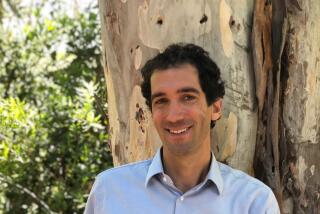Brother Love in the North Woods : CATAMOUNT BRIDGE <i> by Don Metz (Harper & Row: $18.95; 272 pp.) </i>
- Share via
Late in Don Metz’s novel of the north country of Vermont, a character reacts to the terse platitudes of a funeral sermon, wondering why the preacher won’t mention “something real,” like the deceased’s skill at tracking deer, his baby girl, or his widow’s house mortgage. It is a criticism that couldn’t be made of this fine first novel.
From the opening pages, “Catamount Bridge” captures the feel and sounds of a harsh life in a harsh land, evoking the cathedral quiet of a barn in the early morning, the sweet redolence of hay in the mow, the security that animal warmth and bedding provides against the world outside. Metz understands and conveys the subtle symbiosis of men and their machines. We can imagine that skill and forceful drive as a root is ripped from the earth by a powerful D-7 Cat. When a backhoe digs a foundation, we see the sharp cuts of the earth, the delicacy of a brute machine. We see the “surprising blue” of entrails amid the expected mauve and vermilion, as men gut a deer. We follow a man hunting rabbits, knowing he won’t shoot anything, and we share his acute awareness of the woods around him, the heightened perceptions that are as much a draw of the hunt as the kill itself.
The rhythms of rural speech, too, are convincing. A friend from childhood calls Harmon, “Har-mone.” An old man, feeling out of sorts, says he is “discombobulated . . . like I was mental.” And when we overhear two loggers talking of sex, food, and work in staccato, unfinished phrases, their tone alternating between bravado and scarcely masked insecurity, we can picture the peaveys and chains, hear the noise of the skidders and saws. We’re deep in the north country woods.
The multiple viewpoints of the novel--twin brothers, the wife of one, their mother, their grandfather--enrich the characterizations through cross perceptions and reactions. The characters are less convincing when the omniscient narrator tries to package them in stretched metaphors. One twin is “a steady breeze . . . predictable,” the other is a “gathering storm, imperious thunderclouds with lightning at the center.” We know these brothers through dialogue and action: one is eager to go to Vietnam, the other says he will flee to Canada instead; one is gentle and soft-spoken, the other aggressive and curt. They are real characters, not Tobacco Road caricatures; they are better than the cliched metaphor. Later, when we discover that the brothers feel one another’s pain, like the Corsican Brothers of the film and fiction, the revelation jars with the metaphorical characterization.
The plot, or lack of plot, is the weakness of this novel. From the jacket copy on, we are supposed to care what happened when one brother and the wife of the other spent part of an evening together, alone in a hiding place on the Catamount Bridge. For reasons that matter more to them than to the reader, they refuse to confirm or deny whether they made love, and hence, whether her husband might not be the father of the baby she is carrying. Adultery, disputed patrimony, and sibling rivalry are the oldest themes in literature, and the sparse setting of north country Vermont gives the novel a biblical simplicity. But the plot hook fails to engage us because Metz has fiddled with one of those rules that novelists learn only with experience: readers get suspicious when authors withhold information.
The joy of “Catamount Bridge’ isn’t the frail plot, but the characters and the land, portrayed with loving attention and skill. When a son takes his mother’s arm at a funeral, he realizes that he has seen that gesture in too many movies, that he is imitating art. When a late frost stiffens the April mud, we can feel the crunch underfoot. When a man excavates a foundation with a powerful machine, he imagines the rooms that will go there, and the people in them. These are real people in a real world.
More to Read
Sign up for our Book Club newsletter
Get the latest news, events and more from the Los Angeles Times Book Club, and help us get L.A. reading and talking.
You may occasionally receive promotional content from the Los Angeles Times.








